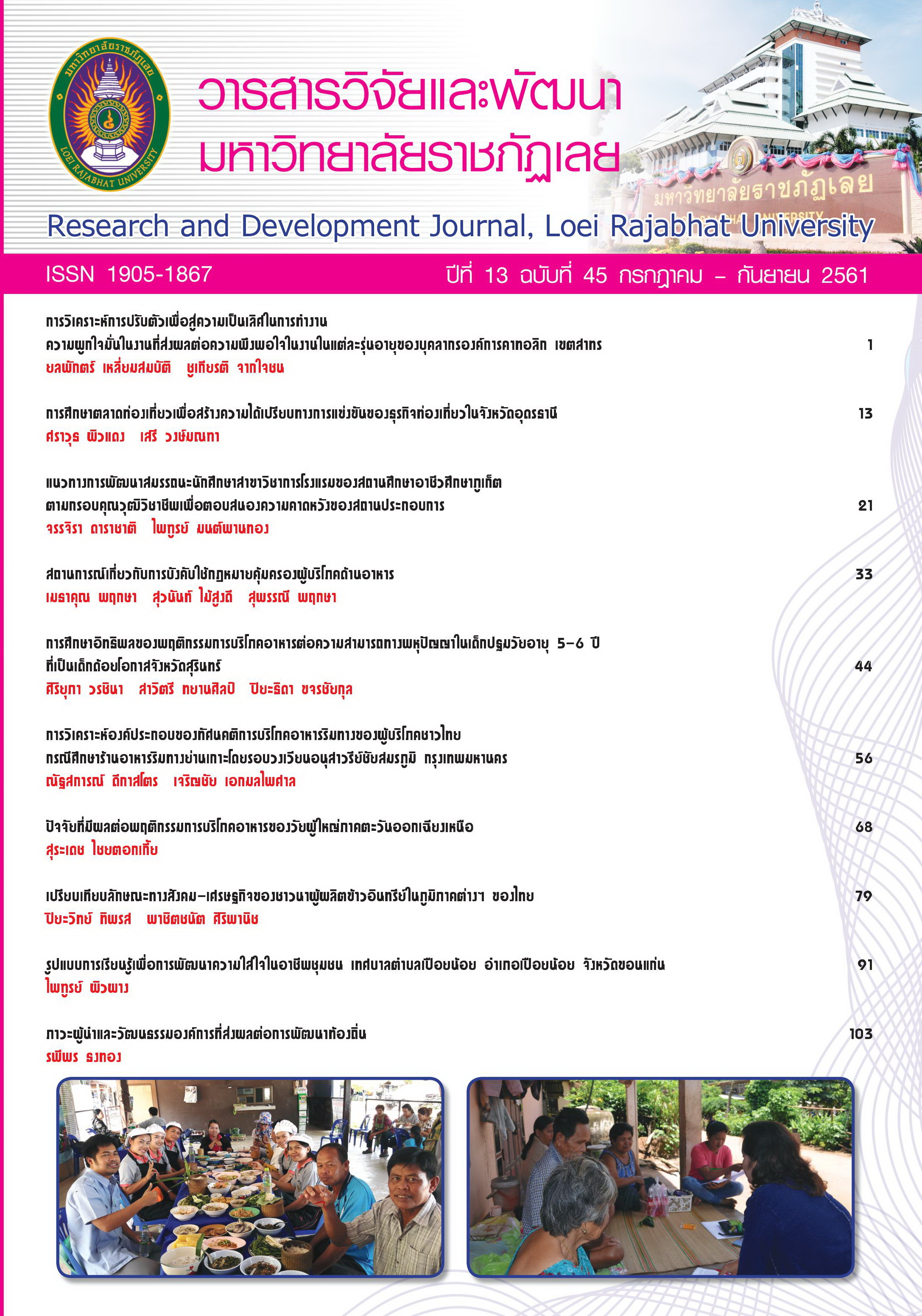การวิเคราะห์องค์ประกอบของทัศนคติการบริโภคอาหารริมทางของผู้บริโภคชาวไทย กรณีศึกษาร้านอาหารริมทางย่านเกาะโดยรอบวงเวียนอนุสาวรีย์ชัยสมรภูมิ กรุงเทพมหานคร
Keywords:
อาหารริมทาง, การท่องเที่ยวเชิงอาหาร, ทัศนคติการบริโภคอาหาร, street food, food tourism, food consumption attitudeAbstract
การวิจัยครั้งนี้มีวัตถุประสงค์ เพื่อวิเคราะห์องค์ประกอบเชิงสำรวจ วิเคราะห์องค์ประกอบเชิงยืนยัน ของแบบวัดทัศนคติในกลุ่มผู้บริโภคอาหารริมทาง และเสนอแนะแนวทาง เพื่อการพัฒนาการท่องเที่ยวอาหารริมทาง โดยใช้แบบสอบถามเป็นเครื่องมือในการเก็บข้อมูลจากผู้บริโภคที่เดินทางมารับประทานอาหารริมทางในย่านเกาะโดยรอบวงเวียนอนุสาวรีย์ชัยสมรภูมิ จำนวน 310 คน วิเคราะห์ข้อมูลโดยใช้เทคนิคการวิเคราะห์องค์ประกอบเชิงสำรวจ และ เทคนิคการวิเคราะห์องค์ประกอบเชิงยืนยัน ผลการวิจัย พบว่า องค์ประกอบของทัศนคติที่มีต่อการบริโภคอาหารริมทางมี 4 องค์ประกอบ คือ 1) ด้านผลิตภัณฑ์และบริการ ซึ่งประกอบไปด้วยตัวแปร รสชาติอาหาร ความหลากหลายของอาหาร มีการบริการดี และ มีมนุษย์สัมพันธ์ 2) ด้านความปลอดภัย ซึ่งประกอบไปด้วยตัวแปร สารปนเปื้อนในวัตถุดิบ เชื้อโรคปนเปื้อนในอาหาร สารอาหารครบถ้วน และ ภาชนะบรรจุปลอดภัย 3) ด้านคุณค่าความรู้สึก ซึ่งประกอบไปด้วยตัวแปร ความดั้งเดิม มีเอกลักษณ์ บริการรวดเร็วทันใจ และ ราคาถูก และ 4) ด้านความสะอาด ซึ่งประกอบไปด้วยตัวแปร สถานที่สะอาด ครัวสะอาด และ อาหารสะอาด ผลการทดสอบความสอดคล้องของโมเดลกับข้อมูลเชิงประจักษ์ พบว่า องค์ประกอบทุกตัวมีความสอดคล้องกลมกลืนในระดับดี โดยมีค่าดัชนี c2 /df = 2.436, CFI = 0.947, TLI = 0.936, RMSEA = 0.069, SRMR = 0.054 โดยการดำเนินงานร้านอาหารริมทางควรให้ความสำคัญด้านมาตรฐานความปลอดภัย พัฒนาผลิตภัณฑ์และการบริการ ให้มีความหลากหลาย สร้างคุณค่าและอารมณ์ความรู้สึก ให้ผู้บริโภครับรู้ถึงเอกลักษณ์ของอาหารริมทางที่ชัดเจนยิ่งขึ้น และให้ความสำคัญด้านความสะอาด โดยเฉพาะอย่างยิ่ง ความสะอาดของสถานที่ให้บริการ และ การศึกษาครั้งต่อไปควรศึกษาองค์ประกอบด้านอื่นเพิ่มเติม เพื่อนำข้อมูลที่ได้จากการศึกษาไปปรับปรุงเพื่อทำให้สามารถทราบถึงองค์ประกอบในด้านอื่นๆ ของทัศนคติการบริโภคอาหารริมทาง ของผู้บริโภคชาวไทย กรณีศึกษาร้านอาหารริมทาง ย่านเกาะโดยรอบวงเวียนอนุสาวรีย์ชัยสมรภูมิ กรุงเทพมหานคร ต่อไป
The purpose of this research is to analyze the factors influencing Thai consumers’ attitude towards street food sold nearby the Victory Monument roundabout area and provide recommendations intended to develop the gastronomic tourism. The research was based on data collected by questionnaire from a sample of 310 Thai people, who have experienced of street food consumption at victory monument area. Data was then analyzed using the concept of Exploratory Factor Analysis (EFA) and Confirmatory Factor Analysis (CFA). The results found four significant components: 1) food and service – specifically, the food products sold including taste and variety of food, and service focusing on the service mind and friendliness of the vendor; 2) safety factors including contaminants in the raw materials, contamination pathogens, nutrients, and the safety container utilized; 3) value and emotional satisfaction – that is, originality, uniqueness, speed of service, and price; 4) cleanliness including the perceived cleanliness of the place, the kitchen, and the food products sold. The results were in line with the model consistency tests: c2 /df = 2.436, CFI = 0.947, TLI = 0.936, RMSEA = 0.069, SRMR = 0.054. The summary recommendations are that street food providers should pay attention to food safety standards, the variety of street food offered for sale, the unique characteristics of the street food, and more pay attention to street food hygiene, especially the cleanliness of the place. For further research, additional factors should be explored in order to discover the main elements that are likely to improve Thai consumer’s attitudes towards street food consumption.
References
กระทรวงท่องเที่ยวแห่งประเทศไทย. (2560). Food Tourism 2.0. สืบค้น 14 สิงหาคม 2559, จากhttps://etatjournal.com/web/menu-read-tat/ menu-2017/92-cate-2017-jan-mar/757-12017-food-tourism2.
จำเนียร ชุณหโสภาค และคณะ. (2558). รายงานการวิจัย เรื่อง การมีส่วนร่วมของชุมชนในการกำหนดนโยบายการบริหารจัดการการท่องเที่ยวด้านการเรียนรู้เกี่ยวกับอาหารไทยและของกลุ่มท่องเที่ยว Active Beach เพื่อรองรับการรวมกลุ่มประชาคมเศรษฐกิจอาเซียน (รายงานผลการวิจัย). กรุงเทพฯ : สำนักงานคณะกรรมการวิจัยแห่งชาติ และสำนักงานกองทุนสนับสนุนการวิจัย.
ฐิตาภัทร์ รัตน์นิธิพงศ์. (2554). ปัจจัยที่มีผลต่อพฤติกรรมการบริโภคอาหารจากร้านอาหารหาบเร่แผงลอยบนถนนสีลมของผู้บริโภคกลุ่มวัยทำงาน. (สารนิพนธ์ปริญญาบริหารธุรกิจมหาบัณฑิต สาขาวิชาการตลาด). กรุงเทพฯ: มหาวิทยาลัยศรีนครินทรวิโรฒ.
ณฤดี ศิรฐานนท์. (2556). พฤติกรรมการรับประทานอาหารริมทางในย่านถนนเยาวราชของผู้บริโภควัยทำงานในกรุงเทพมหานคร. (วิทยานิพนธ์ปริญญามหาบัณฑิต สาขาวิชาการตลาด). กรุงเทพฯ: มหาวิทยาลัยศรีนครินทรวิโรฒ.
บรรจง สุวรรณ. (2552). ทัศนคติของผู้บริโภคอาหารจานด่วนที่มีต่อปัจจัยส่วนประสมทางการตลาดของร้านอาหารจานด่วนในศูนย์การค้าฟิวเจอร์พาร์ค รังสิต และศูนย์ไอทีและอิเล็กทรอนิคส์ เซียร์รังสิต. (วิทยานิพนธ์ปริญญามหาบัณฑิต สาขาบริหารธุรกิจ). ปทุมธานี: มหาวิทยาลัยอีสเทิร์นเอเซีย.
ลักษณ์นาราข์ พันวราสิน. (2553). เปรียบเทียบทัศนคติและพฤติกรรมของผู้บริโภค ไอศกรีมวอลล์ และไอศกรีมเนสท์เล่ ของผู้บริโภคในเขตกรุงเทพมหานคร. (สารนิพนธ์บริหารธุรกิจมหาบัณฑิต สาขาวิชาการจัดการ). กรุงเทพฯ: มหาวิทยาลัยศรีนครินทรวิโรฒ.
สมภูมิ แสวงกุล. (2549). รายงานการวิจัยเรื่อง รูปแบบความต้องการของผู้บริโภคที่มีต่อการค้าหาบเร่แผงลอย กรณีศึกษา: ย่านอนุสาวรีย์ชัยสมรภูมิ (รายงานผลการวิจัย). กรุงเทพฯ: มหาวิทยาลัยราชภัฏสวนสุนันทา.
สันติพจน์ กลับดี. (2558, 2 มิถุนายน). วัฒนธรรมอาหารริมทางกับการสร้างรายได้ให้ประเทศ. สืบค้น 14 สิงหาคม 2559, จากhttps://www.aseanthai. net/ewt_news.php?nid=3223&filename=index.
อรรถจักร์ สัตยานุรักษ์. (2560). ร้านอาหารข้างถนน: ความหมายและความสำคัญ. กรุงเทพธุรกิจ. สืบค้น 14 สิงหาคม 2560, จาก https://www. bangkokbiznews.com/blog/detail/640864.
อาภรณ์พรรณ โพธิ์ยวง. (2549). ความรู้ เจตคติ และการปฏิบัติของผู้ประกอบการร้านอาหารริมบาทวิถี และสุขาภิบาลอาหารริมทางในเขตลาดกระบัง กรุงเทพมหานคร. (วิทยานิพนธ์ปริญญามหาบัณฑิต สาขาโภชนวิทยา). กรุงเทพฯ: มหาวิทยาลัยมหิดล.
Awang, Z. (2012). Structural equation modeling using AMOS graphic. Penerbit Universiti Teknologi: MARA.
Bornstein, M. H., Jager, J., & Putnick, D. L. (2013). Sampling in developmental science: Situations, shortcomings, solutions, and standards. Developmental Review, 33(4), 357-370.
Camillo, A., & Ab. Karim, M. S. (2014). Consumer Attitudes and Perceptions towards Western Cuisine: A Strategic Investigation of the Italian Restaurant Industry in Malaysia. Journal of Foodservice Business Research, 17(2), 103-121.
Chavarria, L. C. T., & Phakdee-auksorn, P. (2017). Understanding international tourists' attitudes towards street food in Phuket, Thailand. Tourism Management Perspectives, 21, 66-73.
Shea, G. (2017, June 24). Best 23 cities for street food. CNN. Retrieved August 14, 2017, from https://edition.cnn.com/travel/article/best-cities-street-food/index.html
Comrey, A., & Lee, H. (1992). A First Course in Factor Analysis. (2nd ed.). New York: Lawrence Erlbaum Association.
Hair, J. F., Black, W. C., & Babin, B. J., Anderson, R. E. (2014). Multivariate Data Analysis. (7th ed.). Essex: Pearson.
Hu, L., & Bentler, P. M. (1999). Cutoff criteria for fit indexes in covariance structure analysis: Conventional criteria versus new alternatives. Structural Equation Modeling: A Multidisciplinary Journal, 6(1), 1-55.
Mueller, R. O. (1996). Basic Principles of Structural Equation Modeling: An Introduction to LISREL and EQS. New York: Springer.
Myers, N. D., Ahn, S., & Jin, Y. (2011). Sample size and power estimates for a confirmatory factor analytic model in exercise and sport: A Monte Carlo approach. Research Quarterly for Exercise and Sport, 82(3), 412–423.
Omemu, A. M., & Aderoju, S. T. (2008). Food safety knowledge and practices of street food vendors in the city of Abeokuta, Nigeria. Food Control, 19(4), 396-402.
Samapundo, S., Cam Thanh, T. N., Xhaferi, R., & Devlieghere, F. (2016). Food safety knowledge, attitudes and practices of street food vendors and consumers in Ho Chi Minh city, Vietnam. Food Control, 70, 79-89.
Sazabiz. (2017). ThaiHRhub Travel blog: Victoria Monument Market. Retreived August 14, 2017, from https://www.thaihrhub.com/bangkok/markets
Downloads
Published
How to Cite
Issue
Section
License
ข้อความที่ปรากฎในวารสารฉบับนี้เป็นความคิดเห็นของผู้เขียนแต่ละท่าน สถาบันวิจัยและพัฒนา มหาวิทยาลัยราชภัฏเลย และกองบรรณาธิการ ไม่จำเป็นต้องเห็นด้วยและไม่มีส่วนรับผิดชอบใดๆ
สถาบันวิจัยและพัฒนา มหาวิทยาลัยราชภัฏเลย ขอให้ผู้อ่านอ้างอิงในกรณีที่ท่านคัดลอกเนื้อหาบทความในวารสารฉบับนี้






